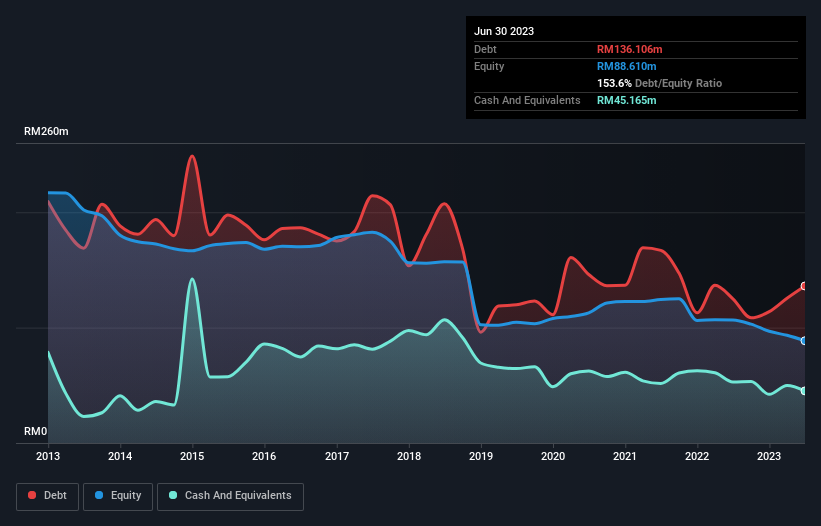We Think HeiTech Padu Berhad (KLSE:HTPADU) Is Taking Some Risk With Its Debt
Legendary fund manager Li Lu (who Charlie Munger backed) once said, 'The biggest investment risk is not the volatility of prices, but whether you will suffer a permanent loss of capital.' So it seems the smart money knows that debt - which is usually involved in bankruptcies - is a very important factor, when you assess how risky a company is. As with many other companies HeiTech Padu Berhad (KLSE:HTPADU) makes use of debt. But the real question is whether this debt is making the company risky.
Why Does Debt Bring Risk?
Generally speaking, debt only becomes a real problem when a company can't easily pay it off, either by raising capital or with its own cash flow. In the worst case scenario, a company can go bankrupt if it cannot pay its creditors. However, a more common (but still painful) scenario is that it has to raise new equity capital at a low price, thus permanently diluting shareholders. By replacing dilution, though, debt can be an extremely good tool for businesses that need capital to invest in growth at high rates of return. When we examine debt levels, we first consider both cash and debt levels, together.
See our latest analysis for HeiTech Padu Berhad
How Much Debt Does HeiTech Padu Berhad Carry?
The image below, which you can click on for greater detail, shows that at June 2023 HeiTech Padu Berhad had debt of RM136.1m, up from RM124.9m in one year. However, because it has a cash reserve of RM45.2m, its net debt is less, at about RM90.9m.

A Look At HeiTech Padu Berhad's Liabilities
According to the last reported balance sheet, HeiTech Padu Berhad had liabilities of RM215.8m due within 12 months, and liabilities of RM18.3m due beyond 12 months. Offsetting this, it had RM45.2m in cash and RM104.5m in receivables that were due within 12 months. So its liabilities outweigh the sum of its cash and (near-term) receivables by RM84.4m.
When you consider that this deficiency exceeds the company's RM73.9m market capitalization, you might well be inclined to review the balance sheet intently. In the scenario where the company had to clean up its balance sheet quickly, it seems likely shareholders would suffer extensive dilution.
We use two main ratios to inform us about debt levels relative to earnings. The first is net debt divided by earnings before interest, tax, depreciation, and amortization (EBITDA), while the second is how many times its earnings before interest and tax (EBIT) covers its interest expense (or its interest cover, for short). Thus we consider debt relative to earnings both with and without depreciation and amortization expenses.
HeiTech Padu Berhad's debt is 3.0 times its EBITDA, and its EBIT cover its interest expense 5.7 times over. Taken together this implies that, while we wouldn't want to see debt levels rise, we think it can handle its current leverage. Notably, HeiTech Padu Berhad's EBIT launched higher than Elon Musk, gaining a whopping 730% on last year. When analysing debt levels, the balance sheet is the obvious place to start. But it is HeiTech Padu Berhad's earnings that will influence how the balance sheet holds up in the future. So when considering debt, it's definitely worth looking at the earnings trend. Click here for an interactive snapshot.
Finally, a company can only pay off debt with cold hard cash, not accounting profits. So we always check how much of that EBIT is translated into free cash flow. In the last three years, HeiTech Padu Berhad created free cash flow amounting to 4.0% of its EBIT, an uninspiring performance. That limp level of cash conversion undermines its ability to manage and pay down debt.
Our View
HeiTech Padu Berhad's level of total liabilities and conversion of EBIT to free cash flow definitely weigh on it, in our esteem. But the good news is it seems to be able to grow its EBIT with ease. When we consider all the factors discussed, it seems to us that HeiTech Padu Berhad is taking some risks with its use of debt. So while that leverage does boost returns on equity, we wouldn't really want to see it increase from here. The balance sheet is clearly the area to focus on when you are analysing debt. But ultimately, every company can contain risks that exist outside of the balance sheet. For instance, we've identified 1 warning sign for HeiTech Padu Berhad that you should be aware of.
When all is said and done, sometimes its easier to focus on companies that don't even need debt. Readers can access a list of growth stocks with zero net debt 100% free, right now.
Valuation is complex, but we're here to simplify it.
Discover if HeiTech Padu Berhad might be undervalued or overvalued with our detailed analysis, featuring fair value estimates, potential risks, dividends, insider trades, and its financial condition.
Access Free AnalysisHave feedback on this article? Concerned about the content? Get in touch with us directly. Alternatively, email editorial-team (at) simplywallst.com.
This article by Simply Wall St is general in nature. We provide commentary based on historical data and analyst forecasts only using an unbiased methodology and our articles are not intended to be financial advice. It does not constitute a recommendation to buy or sell any stock, and does not take account of your objectives, or your financial situation. We aim to bring you long-term focused analysis driven by fundamental data. Note that our analysis may not factor in the latest price-sensitive company announcements or qualitative material. Simply Wall St has no position in any stocks mentioned.
About KLSE:HTPADU
HeiTech Padu Berhad
Provides systems integration, data center management, disaster recovery, information technology, and network related services in Malaysia, Australia, and Indonesia.
Proven track record with slight risk.
Similar Companies
Market Insights
Community Narratives



